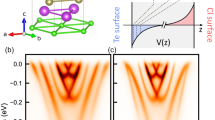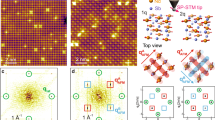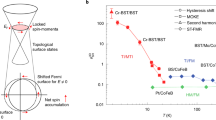Abstract
Surface states of three-dimensional topological insulators exhibit the phenomenon of spin–momentum locking, whereby the orientation of an electron spin is determined by its momentum. Probing the spin texture of these states is of critical importance for the realization of topological insulator devices, but the main technique currently available is spin- and angle-resolved photoemission spectroscopy. Here we reveal a close link between the spin texture and a new kind of magnetoresistance, which depends on the relative orientation of the current with respect to the magnetic field as well as the crystallographic axes, and scales linearly with both the applied electric and magnetic fields. This bilinear magnetoelectric resistance can be used to map the spin texture of topological surface states by simple transport measurements. For a prototypical Bi2Se3 single layer, we can map both the in-plane and out-of-plane components of the spin texture (the latter arising from hexagonal warping). Theoretical calculations suggest that the bilinear magnetoelectric resistance originates from conversion of a non-equilibrium spin current into a charge current under application of the external magnetic field.
This is a preview of subscription content, access via your institution
Access options
Access Nature and 54 other Nature Portfolio journals
Get Nature+, our best-value online-access subscription
$29.99 / 30 days
cancel any time
Subscribe to this journal
Receive 12 print issues and online access
$209.00 per year
only $17.42 per issue
Buy this article
- Purchase on Springer Link
- Instant access to full article PDF
Prices may be subject to local taxes which are calculated during checkout





Similar content being viewed by others
References
Fu, L., Kane, C. L. & Mele, E. J. Topological insulators in three dimensions. Phys. Rev. Lett. 98, 106803 (2007).
Hasan, M. Z. & Kane, C. L. Colloquium: Topological insulators. Rev. Mod. Phys. 82, 3045–3067 (2010).
Qi, X.-L. & Zhang, S.-C. The quantum spin Hall effect and topological insulators. Phys. Today 63, 33–38 (2010).
Yazyev, O. V., Moore, J. E. & Louie, S. G. Spin polarization and transport of surface states in the topological insulators Bi2Se3 and Bi2Te3 from first principles. Phys. Rev. Lett. 105, 266806 (2010).
Garate, I. & Franz, M. Inverse spin-galvanic effect in the interface between a topological insulator and a ferromagnet. Phys. Rev. Lett. 104, 146802 (2010).
Pesin, D. & MacDonald, A. H. Spintronics and pseudospintronics in graphene and topological insulators. Nat. Mater. 11, 409–416 (2012).
Hsieh, D. et al. A tunable topological insulator in the spin helical Dirac transport regime. Nature 460, 1101–1105 (2009).
Hsieh, D. et al. Observation of unconventional quantum spin textures in topological insulators. Science 323, 919–922 (2009).
Nishide, A. et al. Direct mapping of the spin-filtered surface bands of a three-dimensional quantum spin Hall insulator. Phys. Rev. B 81, 041309 (2010).
Fu, L. Hexagonal warping effects in the surface states of the topological insulator Bi2Te3. Phys. Rev. Lett. 103, 266801 (2009).
Kuroda, K. et al. Hexagonally deformed fermi surface of the 3D topological insulator Bi2Se3. Phys. Rev. Lett. 105, 076802 (2010).
Alpichshev, Z. et al. STM imaging of electronic waves on the surface of Bi2Te3: topologically protected surface states and hexagonal warping effects. Phys. Rev. Lett. 104, 016401 (2010).
Wang, Y. H. et al. Observation of a warped helical spin texture in Bi2Se3 from circular dichroism angle-resolved photoemission spectroscopy. Phys. Rev. Lett. 107, 207602 (2011).
Souma, S. et al. Direct measurement of the out-of-plane spin texture in the Dirac-cone surface state of a topological insulator. Phys. Rev. Lett. 106, 216803 (2011).
Xu, S.-Y. et al. Realization of an isolated Dirac node and strongly modulated spin texture in the topological insulator Bi2Te3. Preprint at https://arxiv.org/abs/1101.3985 (2011).
Nomura, M. et al. Relationship between Fermi surface warping and out-of-plane spin polarization in topological insulators: a view from spin- and angle-resolved photoemission. Phys. Rev. B 89, 045134 (2014).
McIver, J. W., Hsieh, D., Steinberg, H., Jarillo-Herrero, P. & Gedik, N. Control over topological insulator photocurrents with light polarization. Nat. Nanotech. 7, 96–100 (2012).
Besbas, J. et al. Helicity-dependent photovoltaic effect in Bi2Se3 under normal incident light. Adv. Opt. Mater. 4, 1642–1650 (2016).
Li, C. H. et al. Electrical detection of charge-current-induced spin polarization due to spin–momentum locking in Bi2Se3. Nat. Nanotech. 9, 218–224 (2014).
Ando, Y. et al. Electrical detection of the spin polarization due to charge flow in the surface state of the topological insulator Bi1.5Sb0.5Te1.7Se1.3. Nano Lett. 14, 6226–6230 (2014).
Tang, J. et al. Electrical detection of spin-polarized surface states conduction in (Bi0.53Sb0.47)2Te3 topological insulator. Nano Lett. 14, 5423–5429 (2014).
Tian, J., Miotkowski, I., Hong, S. & Chen, Y. P. Electrical injection and detection of spin-polarized currents in topological insulator Bi2Te2Se. Sci. Rep. 5, 14293 (2015).
Dankert, A., Geurs, J., Kamalakar, M. V., Charpentier, S. & Dash, S. P. Room temperature electrical detection of spin polarized currents in topological insulators. Nano Lett. 15, 7976–7981 (2015).
Chen, J. et al. Gate-voltage control of chemical potential and weak antilocalization in Bi2Se3. Phys. Rev. Lett. 105, 176602 (2010).
Steinberg, H., Laloë, J. B., Fatemi, V., Moodera, J. S. & Jarillo-Herrero, P. Electrically tunable surface-to-bulk coherent coupling in topological insulator thin films. Phys. Rev. B 84, 233101 (2011).
Banerjee, K. et al. Defect-induced negative magnetoresistance and surface state robustness in the topological insulator BiSbTeSe2. Phys. Rev. B 90, 235427 (2014).
Tang, H., Liang, D., Qiu, R. L. J. & Gao, X. P. A. Two-dimensional transport-induced linear magneto-resistance in topological insulator Bi2Se3 nanoribbons. ACS Nano 5, 7510–7516 (2011).
Wang, X., Du, Y., Dou, S. & Zhang, C. Room temperature giant and linear magnetoresistance in topological insulator Bi2Te3 nanosheets. Phys. Rev. Lett. 108, 266806 (2012).
He, H. et al. High-field linear magneto-resistance in topological insulator Bi2Se3 thin films. Appl. Phys. Lett. 100, 032105 (2012).
Wang, J. et al. Anomalous anisotropic magnetoresistance in topological insulator films. Nano Res. 5, 739–746 (2012).
Sulaev, A. et al. Electrically tunable in-plane anisotropic magnetoresistance in topological insulator BiSbTeSe2 nanodevices. Nano Lett. 15, 2061–2066 (2015).
Yasuda, K. et al. Large unidirectional magnetoresistance in a magnetic topological insulator. Phys. Rev. Lett. 117, 127202 (2016).
Avci, C. O. et al. Unidirectional spin Hall magnetoresistance in ferromagnet/normal metal bilayers. Nat. Phys. 11, 570–575 (2015).
Olejník, K., Novák, V., Wunderlich, J. & Jungwirth, T. Electrical detection of magnetization reversal without auxiliary magnets. Phys. Rev. B 91, 180402 (2015).
Kim, K. J. et al. Current-induced asymmetric magnetoresistance due to energy transfer via quantum spin-flip process. Preprint at https://arxiv.org/abs/1603.08746 (2016).
Zhang, S. S. L. & Vignale, G. Theory of unidirectional spin Hall magnetoresistance in heavy-metal/ferromagnetic-metal bilayers. Phys. Rev. B 94, 140411 (2016).
Zhang, H. et al. Topological insulators in Bi2Se3, Bi2Te3 and Sb2Te3 with a single Dirac cone on the surface. Nat. Phys. 5, 438 (2009).
Xia, Y. et al. Observation of a large-gap topological-insulator class with a single Dirac cone on the surface. Nat. Phys. 5, 398–402 (2009).
Manchon, A., Koo, H. C., Nitta, J., Frolov, S. M. & Duine, R. A. New perspectives for Rashba spin–orbit coupling. Nat. Mater. 14, 871–882 (2015).
Ideue, T. et al. Bulk rectification effect in a polar semiconductor. Nat. Phys. 13, 578 (2017).
Wang, Q. H., Kalantar-Zadeh, K., Kis, A., Coleman, J. N. & Strano, M. S. Electronics and optoelectronics of two-dimensional transition metal dichalcogenides. Nat. Nanotech. 7, 699–712 (2012).
Acknowledgements
This work was partially supported by A*STAR’s Pharos Programme on Topological Insulators, Ministry of Education–Singapore Academic Research Fund Tier 1 (R-263-000-B47-112). The work by S.S.-L.Z. and G.V. was supported by National Science Foundation (NSF) grant DMR-1406568, and work on the revised manuscript by S.S.-L.Z. at Argonne National Laboratory was supported by Department of Energy, Office of Science, Basic Energy Sciences, Materials Sciences and Engineering Division. S.S.-L.Z. thanks O. Heinonen, A. Hoffmann, G. Bian, A. Fert, X. Jin, D. Loss and S. Zhang for helpful discussions.
Author information
Authors and Affiliations
Contributions
P.H. and H.Y. planned the study. D.Z. and P.H. fabricated devices. P.H. and D.Z. measured transport properties. Y.L., Y.W. and J.Y. helped with characterization. S.S.-L.Z. and G.V. devised the theory. All authors discussed the results. P.H., S.S.-L.Z., D.Z., G.V. and H.Y. wrote the manuscript. H.Y. supervised the project.
Corresponding author
Ethics declarations
Competing interests
The authors declare no competing financial interests.
Additional information
Publisher’s note: Springer Nature remains neutral with regard to jurisdictional claims in published maps and institutional affiliations.
Supplementary information
Supplementary information
Additional data, including 12 figures and 26 references.
Rights and permissions
About this article
Cite this article
He, P., Zhang, S.SL., Zhu, D. et al. Bilinear magnetoelectric resistance as a probe of three-dimensional spin texture in topological surface states. Nature Phys 14, 495–499 (2018). https://doi.org/10.1038/s41567-017-0039-y
Received:
Accepted:
Published:
Issue Date:
DOI: https://doi.org/10.1038/s41567-017-0039-y
This article is cited by
-
Nonlinear transport and radio frequency rectification in BiTeBr at room temperature
Nature Communications (2024)
-
Light-induced giant enhancement of nonreciprocal transport at KTaO3-based interfaces
Nature Communications (2024)
-
Nonvolatile magnetization switching in a single-layer magnetic topological insulator
Communications Physics (2023)
-
Field-free switching of perpendicular magnetization at room temperature using out-of-plane spins from TaIrTe4
Nature Electronics (2023)
-
Giant magnetochiral anisotropy from quantum-confined surface states of topological insulator nanowires
Nature Nanotechnology (2022)



